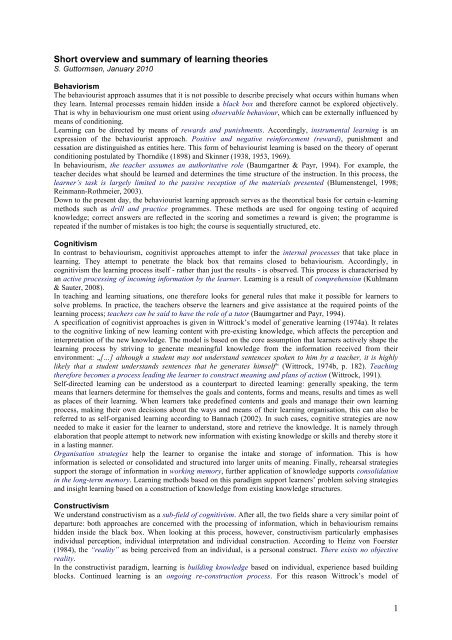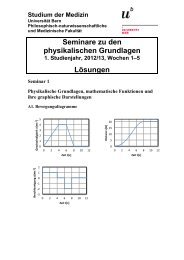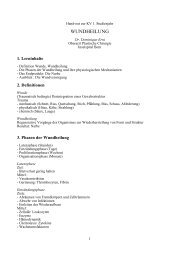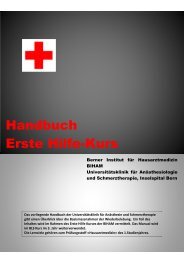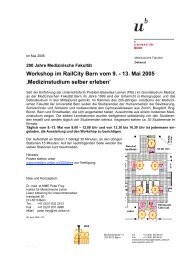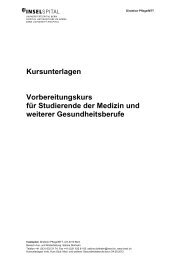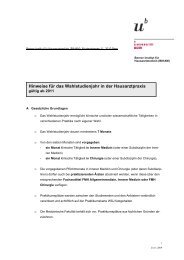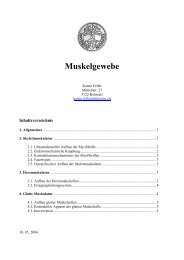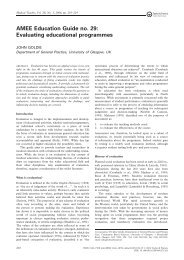1 Short overview and summary of learning theories
1 Short overview and summary of learning theories
1 Short overview and summary of learning theories
Create successful ePaper yourself
Turn your PDF publications into a flip-book with our unique Google optimized e-Paper software.
<strong>Short</strong> <strong>overview</strong> <strong>and</strong> <strong>summary</strong> <strong>of</strong> <strong>learning</strong> <strong>theories</strong><br />
S. Guttormsen, January 2010<br />
Behaviorism<br />
The behaviourist approach assumes that it is not possible to describe precisely what occurs within humans when<br />
they learn. Internal processes remain hidden inside a black box <strong>and</strong> therefore cannot be explored objectively.<br />
That is why in behaviourism one must orient using observable behaviour, which can be externally influenced by<br />
means <strong>of</strong> conditioning.<br />
Learning can be directed by means <strong>of</strong> rewards <strong>and</strong> punishments. Accordingly, instrumental <strong>learning</strong> is an<br />
expression <strong>of</strong> the behaviourist approach. Positive <strong>and</strong> negative reinforcement (reward), punishment <strong>and</strong><br />
cessation are distinguished as entities here. This form <strong>of</strong> behaviourist <strong>learning</strong> is based on the theory <strong>of</strong> operant<br />
conditioning postulated by Thorndike (1898) <strong>and</strong> Skinner (1938, 1953, 1969).<br />
In behaviourism, the teacher assumes an authoritative role (Baumgartner & Payr, 1994). For example, the<br />
teacher decides what should be learned <strong>and</strong> determines the time structure <strong>of</strong> the instruction. In this process, the<br />
learner’s task is largely limited to the passive reception <strong>of</strong> the materials presented (Blumenstengel, 1998;<br />
Reinmann-Rothmeier, 2003).<br />
Down to the present day, the behaviourist <strong>learning</strong> approach serves as the theoretical basis for certain e-<strong>learning</strong><br />
methods such as drill <strong>and</strong> practice programmes. These methods are used for ongoing testing <strong>of</strong> acquired<br />
knowledge; correct answers are reflected in the scoring <strong>and</strong> sometimes a reward is given; the programme is<br />
repeated if the number <strong>of</strong> mistakes is too high; the course is sequentially structured, etc.<br />
Cognitivism<br />
In contrast to behaviourism, cognitivist approaches attempt to infer the internal processes that take place in<br />
<strong>learning</strong>. They attempt to penetrate the black box that remains closed to behaviourism. Accordingly, in<br />
cognitivism the <strong>learning</strong> process itself - rather than just the results - is observed. This process is characterised by<br />
an active processing <strong>of</strong> incoming information by the learner. Learning is a result <strong>of</strong> comprehension (Kuhlmann<br />
& Sauter, 2008).<br />
In teaching <strong>and</strong> <strong>learning</strong> situations, one therefore looks for general rules that make it possible for learners to<br />
solve problems. In practice, the teachers observe the learners <strong>and</strong> give assistance at the required points <strong>of</strong> the<br />
<strong>learning</strong> process; teachers can be said to have the role <strong>of</strong> a tutor (Baumgartner <strong>and</strong> Payr, 1994).<br />
A specification <strong>of</strong> cognitivist approaches is given in Wittrock’s model <strong>of</strong> generative <strong>learning</strong> (1974a). It relates<br />
to the cognitive linking <strong>of</strong> new <strong>learning</strong> content with pre-existing knowledge, which affects the perception <strong>and</strong><br />
interpretation <strong>of</strong> the new knowledge. The model is based on the core assumption that learners actively shape the<br />
<strong>learning</strong> process by striving to generate meaningful knowledge from the information received from their<br />
environment: „[…] although a student may not underst<strong>and</strong> sentences spoken to him by a teacher, it is highly<br />
likely that a student underst<strong>and</strong>s sentences that he generates himself“ (Wittrock, 1974b, p. 182). Teaching<br />
therefore becomes a process leading the learner to construct meaning <strong>and</strong> plans <strong>of</strong> action (Wittrock, 1991).<br />
Self-directed <strong>learning</strong> can be understood as a counterpart to directed <strong>learning</strong>: generally speaking, the term<br />
means that learners determine for themselves the goals <strong>and</strong> contents, forms <strong>and</strong> means, results <strong>and</strong> times as well<br />
as places <strong>of</strong> their <strong>learning</strong>. When learners take predefined contents <strong>and</strong> goals <strong>and</strong> manage their own <strong>learning</strong><br />
process, making their own decisions about the ways <strong>and</strong> means <strong>of</strong> their <strong>learning</strong> organisation, this can also be<br />
referred to as self-organised <strong>learning</strong> according to Bannach (2002). In such cases, cognitive strategies are now<br />
needed to make it easier for the learner to underst<strong>and</strong>, store <strong>and</strong> retrieve the knowledge. It is namely through<br />
elaboration that people attempt to network new information with existing knowledge or skills <strong>and</strong> thereby store it<br />
in a lasting manner.<br />
Organisation strategies help the learner to organise the intake <strong>and</strong> storage <strong>of</strong> information. This is how<br />
information is selected or consolidated <strong>and</strong> structured into larger units <strong>of</strong> meaning. Finally, rehearsal strategies<br />
support the storage <strong>of</strong> information in working memory, further application <strong>of</strong> knowledge supports consolidation<br />
in the long-term memory. Learning methods based on this paradigm support learners’ problem solving strategies<br />
<strong>and</strong> insight <strong>learning</strong> based on a construction <strong>of</strong> knowledge from existing knowledge structures.<br />
Constructivism<br />
We underst<strong>and</strong> constructivism as a sub-field <strong>of</strong> cognitivism. After all, the two fields share a very similar point <strong>of</strong><br />
departure: both approaches are concerned with the processing <strong>of</strong> information, which in behaviourism remains<br />
hidden inside the black box. When looking at this process, however, constructivism particularly emphasises<br />
individual perception, individual interpretation <strong>and</strong> individual construction. According to Heinz von Foerster<br />
(1984), the “reality” as being perceived from an individual, is a personal construct. There exists no objective<br />
reality.<br />
In the constructivist paradigm, <strong>learning</strong> is building knowledge based on individual, experience based building<br />
blocks. Continued <strong>learning</strong> is an ongoing re-construction process. For this reason Wittrock’s model <strong>of</strong><br />
1
generative <strong>learning</strong> can also be classified as a constructivist <strong>learning</strong> paradigm according to Bonn <strong>and</strong><br />
Grabowski (2001) – although Wittrock did not explicitly mention the constructivist approach in any <strong>of</strong> his work.<br />
Self-directed <strong>learning</strong> is also an expression <strong>of</strong> this approach. The expression "explorative <strong>learning</strong>" (also:<br />
discovery <strong>learning</strong>) was coined by Bruner (1961) <strong>and</strong> represents a further expression <strong>of</strong> constructivist <strong>learning</strong>.<br />
Explorative <strong>learning</strong> happens when learners are stimulated by the <strong>learning</strong> environment, are actively engaged in<br />
solving problems, independently acquire their own experience, carry out experiments as the opportunity arises<br />
<strong>and</strong> thereby gain new insights into complex issues <strong>and</strong> principles. According to Bruner (1961), the<br />
transformation <strong>and</strong> (re-)organisation <strong>of</strong> the <strong>learning</strong> material allow it to be adapted to the learner’s individual<br />
cognitive structures <strong>and</strong> make it possible to discover new insights beyond what is given.<br />
In constructivism, the teacher is seen as a coach or a trainer (Baumgartner & Payr, 1994) – the <strong>learning</strong> process<br />
can be stimulated <strong>and</strong> supported externally, but not be totally controlled (Reinmann-Rothmeier, 2003). The<br />
teacher <strong>and</strong> the learner work together to set <strong>learning</strong> goals <strong>and</strong> communicate on the same level. The teacher<br />
assists in identifying <strong>and</strong> solving problems, cooperates with the learner <strong>and</strong> accompanies the <strong>learning</strong> process<br />
(Kuhlmann & Sauter, 2008). In this manner, constructivist <strong>learning</strong> receives a social, collaborative component<br />
(M<strong>and</strong>l et al., 2004; Seufert et al., 2001). When more people take part in such a process, it can be called<br />
distributed cognition according to this paradigm (Hutchins, 2000). Accordingly, knowledge is not strictly<br />
individual but is distributed among several people or a team. According to Kuhlmann <strong>and</strong> Sauter (2008), the<br />
innovative communications instruments <strong>of</strong> Web 2.0 are very well suited to cooperative or collaborative <strong>learning</strong>.<br />
This is because they promote the active participation <strong>of</strong> the learner in the communication process.<br />
Information processing<br />
Information processing <strong>theories</strong> represents another sub-field <strong>of</strong> cognitivism. These <strong>theories</strong> aim at describing the<br />
flow <strong>and</strong> processing <strong>of</strong> information in the human cognitive system from the presentation to the sense organs, the<br />
modalities <strong>of</strong> sensing, the representation in the cognitive system, storing the information (forms, levels <strong>and</strong><br />
processing <strong>of</strong> memory), as well as retrieval, when stored information is needed in order to learn or solving a task.<br />
Within the field <strong>of</strong> cognitive psychology, information processing is an important aspect <strong>of</strong> underst<strong>and</strong>ing human<br />
thinking <strong>and</strong> <strong>learning</strong>.<br />
Three alternatives ideas are prominent: sequentially, parallel-distributed <strong>and</strong> connectionistic processing. The<br />
sequentially idea holds that information is processed in a serial, discontinuous manner as it moves from one<br />
stage to the next. The parallel-distributed processing model states that information is processed simultaneously<br />
by several different parts <strong>of</strong> the memory system, rather than sequentially. This model emphasizes the fact that<br />
information is stored in multiple locations throughout the brain in the form <strong>of</strong> networks <strong>of</strong> connections. The<br />
connectionistic model is consistent with the sequentially processing approach in that the more connections to a<br />
single idea or concept, the more likely it is to be remembered. It is one <strong>of</strong> the dominant forms <strong>of</strong> current research<br />
in cognitive psychology <strong>and</strong> is consistent with the most recent brain research.<br />
Situated Learning<br />
Situated <strong>learning</strong> is concerned with how <strong>learning</strong> occurs everyday. This theory <strong>of</strong>fers a very different view on<br />
<strong>learning</strong> compared to the <strong>theories</strong> presented above. It is not a recommendation that teaching should be "situated"<br />
or "relevant." It is a theory reflecting an important aspect <strong>of</strong> the nature <strong>of</strong> human knowledge, claiming that<br />
knowledge is dynamically constructed as we conceive <strong>of</strong> what is happening to us, talk <strong>and</strong> move. Situated<br />
<strong>learning</strong> was first proposed by Jean Lave <strong>and</strong> Etienne Wenger as a model <strong>of</strong> <strong>learning</strong> in a Community <strong>of</strong><br />
practice. At its simplest, Situated Learning is <strong>learning</strong> that takes place in the same context in which it is applied.<br />
Lave <strong>and</strong> Wenger (1991) argue that <strong>learning</strong> should not be viewed as simply the transmission <strong>of</strong> abstract <strong>and</strong><br />
decontextualised knowledge from one individual to another, but a social process whereby knowledge is coconstructed;<br />
they suggest that such <strong>learning</strong> is situated in a specific context <strong>and</strong> embedded within a particular<br />
social <strong>and</strong> physical environment. Lave <strong>and</strong> Wenger assert that situated <strong>learning</strong> "is not an educational form,<br />
much less a pedagogical strategy" (p.40).<br />
Proponents <strong>of</strong> this theory claim that knowledge is not a thing or set <strong>of</strong> descriptions or collection <strong>of</strong> facts <strong>and</strong><br />
rules. We model knowledge by such descriptions. But the map is not the territory: human knowledge is not like<br />
procedures <strong>and</strong> semantic networks in a computer program. Human knowledge should be viewed as a capacity to<br />
coordinate <strong>and</strong> sequence behaviour, to adapt dynamically to changing circumstances. Underst<strong>and</strong>ing how<br />
<strong>learning</strong> is a process <strong>of</strong> conceiving an activity, <strong>and</strong> activities are inherently social, puts emphasis on improving<br />
<strong>learning</strong> addressing issues <strong>of</strong> membership, participation in a community, <strong>and</strong> identity. Saying that activities are<br />
social has nothing to do per se with whether the activity is done alone or with other people present. Action is<br />
situated because it is constrained by a person's underst<strong>and</strong>ing <strong>of</strong> his or her "place" in a social process.<br />
The ideas <strong>of</strong> the situated <strong>learning</strong> movement have received much attention <strong>and</strong> even enthusiasm in recent years.<br />
However, for the implementation <strong>of</strong> effective <strong>learning</strong> environments based on a rationale <strong>of</strong> situatedness, some<br />
problems have to be solved. Three <strong>of</strong> them are: (1) Neglect <strong>of</strong> specifying the type <strong>of</strong> instructional support that is<br />
necessary for effective situated <strong>learning</strong>, (2) over-confidence in the engagement-inducing potential <strong>of</strong> complex<br />
problems, <strong>and</strong> (3) undifferentiated use <strong>of</strong> the notion "activity". (Renkl et al, 1996)<br />
2
Social Learning<br />
B<strong>and</strong>ura’s ‘Social Learning Theory, mediates between the behavioural, cognitive, <strong>and</strong> Lave’s social view <strong>of</strong><br />
<strong>learning</strong> <strong>and</strong> is an important part <strong>of</strong> the “<strong>learning</strong>-model l<strong>and</strong>scape”. According to B<strong>and</strong>ura people learn through<br />
observing others’ behaviour, attitudes, <strong>and</strong> outcomes <strong>of</strong> those behaviours. “Most human behaviour is learned<br />
observationally through modelling: “From observing others, one forms an idea <strong>of</strong> how new behaviours are<br />
performed, <strong>and</strong> on later occasions this coded information serves as a guide for action.” Social <strong>learning</strong> theory<br />
explains human behaviour in terms <strong>of</strong> continuous reciprocal interaction between cognitive, behavioural, <strong>and</strong><br />
environmental influences. Necessary conditions for effective modelling are:<br />
Attention various factors increase or decrease the amount <strong>of</strong> attention paid.<br />
Retention remembering what you paid attention to. Includes symbolic coding, mental images, cognitive<br />
organization, symbolic rehearsal, motor rehearsal<br />
Reproduction reproducing the image. Including physical capabilities, <strong>and</strong> self-observation <strong>of</strong> reproduction.<br />
Motivation having a good reason to imitate.<br />
B<strong>and</strong>ura considered personality as an interaction between three components: the environment, behaviour, <strong>and</strong><br />
one’s psychological processes (one’s ability to entertain images in minds <strong>and</strong> language).<br />
References<br />
Bannach, M. (2002). Selbstbestimmtes Lernen. Baltmannsweiler: Schneider.<br />
Baumgartner, P., & Payr, S. (1994). Lernen mit S<strong>of</strong>tware. Insbruck: Österreichischer Studien-Verlag.<br />
Blumenstengel, A. (1998). Entwicklung hypermedialer Lernsysteme. Berlin: Wissenschaftlicher Verlag.<br />
Bonn, K. L., & Grabowski, N. L. (2001). Generative Learning theory: A practical cousin to constructivism.<br />
Paper presented at the Joint Meeting <strong>of</strong> Mathematics, New Orleans, LA.<br />
Bruner, J. S. (1961). The act <strong>of</strong> discovery. Harvard Educational Review, 31(1), 21–32.<br />
Foerster, H. von. (1984). On Constructing a Reality. In P. Watzlawick (Ed.), The Invented Reality (41–62). New<br />
York: W. W. Norton.<br />
Hutchins, E. (2000). Distributed Cognition. IESBS, 1–10.<br />
Kuhlmann, A. M., & Sauter, W. (2008). Innovative Lernsysteme. Kompetenzentwicklung mit Blended Learning<br />
und Social S<strong>of</strong>tware. Hamburg: Springer.<br />
Lave, J, Wenger, E. (1991) Situated Learning. Legitimate peripheral participation, Cambridge: University <strong>of</strong><br />
Cambridge Press<br />
M<strong>and</strong>l, H., Kopp, B., & Dvorak, S. (2004). Aktuelle theoretische Ansätze und empirische Befunde im Bereich<br />
der Lehr-Lern-Forschung. München.<br />
Renkl, A., Gruber, H., M<strong>and</strong>l, H. (November 1996): Situated <strong>learning</strong> in instructional settings: From euphoria<br />
to feasibility. (Forschungsbericht Nr. 74). München: Ludwig-Maximilians-Universität, Lehrstuhl für<br />
Empirische Pädagogik und Pädagogische Psychologie, Internet, ISSN 1614-6336<br />
Reinmann-Rothmeier, G. (2003). Didaktische Innovation durch Blended Learning: Leitlinien anh<strong>and</strong> eines<br />
Beispiels aus der Hochschule. Bern: Huber.<br />
Seufert, S., Back, A., & Häusler, M. (2001). E-Learning – Weiterbildung im Internet: Das „Plato-Cookbook“<br />
für internetbasiertes Lernen. Kilchberg.<br />
Shumway, J. M., & Harden, R. M. (2003). AMEE Guide No. 25: The assessment <strong>of</strong> <strong>learning</strong> outcomes for the<br />
competent <strong>and</strong> reflective physician. Medical Teacher, 25(6), 569–584.<br />
Skinner, B. F. (1938). The behavior <strong>of</strong> organisms: An experimental analysis. New York: Appleton-Century-<br />
Cr<strong>of</strong>ts.<br />
Skinner, B. F. (1953). Science <strong>and</strong> human behavior. New York: Macmillan.<br />
Skinner, B. F. (1969). Contingencies <strong>of</strong> reinforcement. New Jersey: Prentice-Hall.<br />
Thorndike, E. L. (1898). Animal intelligence: An experimental study <strong>of</strong> the associative processes in animals.<br />
Psychological Review Monograph Supplement 2 (4, Whole No. 8).<br />
Wittrock, M. C. (1974a). Learning as a generative process. Educational Psychologist, 19(2), 87–95.<br />
Wittrock, M. C. (1974b). A generative model <strong>of</strong> mathematics education. Journal for Research in Mathematics<br />
Education, 5(4), 181–196.<br />
Wittrock, M. C. (1991). Generative teaching <strong>of</strong> comprehension. Elementary School Journal, 92, 167–182.<br />
Wittrock, M. C. (1989). Generative processes <strong>of</strong> comprehension. Educational Psychologist, 24, 345–376.<br />
3


